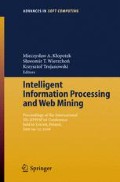Abstract
Employing content based image retrieval (CBIR) methods to trademark registration can improve and accelerate the checking process greatly. Amongst all the features present in CBIR, shape seems to be the most appropriate for this task. It is however usually only utilized for non-occluded and noise free objects. In this paper the emphasis is put on the atypical case of the fraudulent creation of a new trademark based on a popular registered one. One can just modify an existing logo by, for example, removing or inserting a part into it. Another method is to modify even smaller subparts, which is close to adding noise to it’s silhouette. So, a method is herein described of template matching using a shape descriptor which is robust to rotation, scaling, shifting, and also to occlusion and noise.
Access this chapter
Tax calculation will be finalised at checkout
Purchases are for personal use only
Preview
Unable to display preview. Download preview PDF.
References
1. Alfarez R., Wang Y.-F. (1999) Geometric and illumination invariants for object recognition, IEEE Trans. On Pattern Analysis and Machine Intelligence 21, 505–535
2. Antani S., Kasturi R., Jain R. (2002) A survey on the use of pattern recognition methods for abstraction, indexing and retrieval of images and video, Pattern Recognition 35, 945–965
3. Belongie S., Malik J., Puzicha J. (2000) Shape context: a new descriptor for shape matching and object recognition, Proc. of Advances in Neural Information Processing Systems 13, 831–837
4. Bigun J., Bhattacharjee S.K., Michel S. (1996) Orientation radiograms for image retrieval: an alternative to segmentation, Proc. of the IEEE International Conference on Pattern Recognition, 346–350
5. Frejlichowski D. (2003) Problem braku czèsci sylwetki w rozpoznawaniu obrazów konturowych z uÿzyciem przekszta_lcenia do uk_ladu biegunowego, Materialy VIII Sesji Naukowej Informatyki, 181–188
6. Frejlichowski D. (2004) Metoda porównywania zniekszta_lconych dwuwymiarowych obiektów konturowych, Metody Informatyki Stosowanej w Technice i Technologii, 329–334
7. Huang C.-L., Huang D.-H. (1998) A content-based image retrieval system, Image and Vision Computing 16, 149–163
8. Hupkens Th. M., Clippeleir J. de (1995) Noise and intensity invariant moments, Pattern Recognition Letters 16, 371–376
9. Jin L., Tianxu Z. (2004) Fast algorithm for generation of moment invariants, Pattern Recognition 37, 1745–1756
10. Kan C., Srinath M. D. (2002) Invariant character recognition with Zernike and orthogonal Fourier-Mellin moments, Pattern Recognition 35, 143–154
11. Kuchariew G. (1998) Przetwarzanie i Analiza Obrazów Cyfrowych, Politechnika Szczecińska, Wydzia_l Informatyki, Szczecin, Informa
12. Loncaric S. (1998) A survey on shape analysis techniques, Pattern Recognition 31, 983–1001
13. Mokhtarian F. (1997) Silhouette-based occluded object recognition through curvature scale space, Machine Vision and Applications 10, 87–97
14. Rauber T.W. (1994) Two-dimensional shape description, Technical Report: GR UNINOVA-RT-10–94, Universidade Nova de Lisboa
15. Rothe I., Süsse H., Voss K. (1996) The method of normalization to determine invariants, IEEE Trans. on Pattern Analysis and Machine Intelligence 18, 366– 375
16. Shih J. L., Chen L.-H. (2001) A new system for trademark segmentation and retrieval, Image and Vision Computing Journal 19, 1011–1018
17. Tarel J.-P., Cooper D. B. (2000) The complex representation of algebraic curves and its simple exploitation for pose estimation and invariant recognition, IEEE Trans. on Pattern Analysis and Machine Intelligence 22, 663–674
18. Zhang D., Lu G. (2002) Shape-based image retrieval using Generic Fourier Descriptor, Signal Processing: Image Communication 17, 825–848
Author information
Authors and Affiliations
Editor information
Editors and Affiliations
Rights and permissions
Copyright information
© 2006 Springer
About this paper
Cite this paper
Frejlichowski, D. (2006). Trademark Retrieval in the Presence of Occlusion. In: Kłopotek, M.A., Wierzchoń, S.T., Trojanowski, K. (eds) Intelligent Information Processing and Web Mining. Advances in Soft Computing, vol 35. Springer, Berlin, Heidelberg. https://doi.org/10.1007/3-540-33521-8_25
Download citation
DOI: https://doi.org/10.1007/3-540-33521-8_25
Publisher Name: Springer, Berlin, Heidelberg
Print ISBN: 978-3-540-33520-7
Online ISBN: 978-3-540-33521-4
eBook Packages: EngineeringEngineering (R0)

